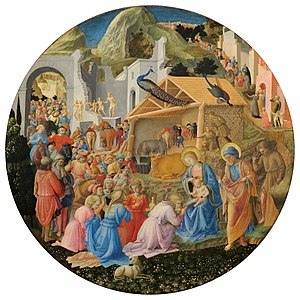嗨!BureibuNeko,
您收到此通知,是因为您作为一名中文和粤语的翻译者在Meta注册了。页面Help:Two-factor authentication已可供翻译。您可在此翻译:
这个页面有中重要度。
非常感谢您的帮助。像您一样的翻译者正在不断努力帮助Meta成为一个真正多语言的社区。
要取消订阅或更改您的翻译通知设置,请访问Special:TranslatorSignup。
谢谢!
Meta翻译协调员, 2024年2月12日 (一) 13:49 (UTC)
嗨!BureibuNeko,
您收到此通知,是因为您作为一名中文和粤语的翻译者在Meta注册了。页面Help:Two-factor authentication已可供翻译。您可在此翻译:
这个页面有中重要度。
非常感谢您的帮助。像您一样的翻译者正在不断努力帮助Meta成为一个真正多语言的社区。
要取消订阅或更改您的翻译通知设置,请访问Special:TranslatorSignup。
谢谢!
Meta翻译协调员, 2024年2月12日 (一) 13:49 (UTC)
| The winner this Translation of the week is
Please be bold and help translate this article!  The Adoration of the Magi is a tondo, or circular painting, of the Adoration of the Magi assumed to be that recorded in 1492 in the Palazzo Medici Riccardi in Florence as by Fra Angelico. It dates from the mid-15th century and is now in the National Gallery of Art in Washington D.C. Most art historians think that Filippo Lippi painted more of the original work, and that it was added to some years after by other artists, as well as including work by assistants in the workshops of both the original masters. It has been known as the Washington Tondo and Cook Tondo after Herbert Cook, and this latter name in particular continues to be used over 50 years after the painting left the Cook collection. (Please update the interwiki links on Wikidata of your language version of the article after each week's translation is finished so that all languages are linked to each other.)
|
嗨!BureibuNeko,
您收到此通知,是因为您作为一名中文和粤语的翻译者在Meta注册了。页面User groups已可供翻译。您可在此翻译:
这个页面有中重要度。
非常感谢您的帮助。像您一样的翻译者正在不断努力帮助Meta成为一个真正多语言的社区。
要取消订阅或更改您的翻译通知设置,请访问Special:TranslatorSignup。
谢谢!
Meta翻译协调员, 2024年2月11日 (日) 15:41 (UTC)
嗨!BureibuNeko,
您收到此通知,是因为您作为一名中文和粤语的翻译者在Meta注册了。页面User groups已可供翻译。您可在此翻译:
这个页面有中重要度。
非常感谢您的帮助。像您一样的翻译者正在不断努力帮助Meta成为一个真正多语言的社区。
要取消订阅或更改您的翻译通知设置,请访问Special:TranslatorSignup。
谢谢!
Meta翻译协调员, 2024年2月11日 (日) 05:31 (UTC)
嗨!BureibuNeko,
您收到此通知,是因为您作为一名中文和粤语的翻译者在Meta注册了。页面Staff group已可供翻译。您可在此翻译:
这个页面有低重要度。
非常感谢您的帮助。像您一样的翻译者正在不断努力帮助Meta成为一个真正多语言的社区。
要取消订阅或更改您的翻译通知设置,请访问Special:TranslatorSignup。
谢谢!
Meta翻译协调员, 2024年2月11日 (日) 04:08 (UTC)
嗨!BureibuNeko,
您收到此通知,是因为您作为一名粤语的翻译者在Meta注册了。页面Wikidata已可供翻译。您可在此翻译:
这个页面有中重要度。
非常感谢您的帮助。像您一样的翻译者正在不断努力帮助Meta成为一个真正多语言的社区。
要取消订阅或更改您的翻译通知设置,请访问Special:TranslatorSignup。
谢谢!
Meta翻译协调员, 2024年2月11日 (日) 03:44 (UTC)
| The winner this Translation of the week is
Please be bold and help translate this article!  Timurid architecture was an important stage in the architectural history of Iran and Central Asia during the late 14th and 15th centuries. The Timurid Empire (1370–1507), founded by Timur (d. 1405) and conquering most of this region, oversaw a cultural renaissance. In architecture, the Timurid dynasty patronized the construction of palaces, mausoleums, and religious monuments across the region. Their architecture is distinguished by its grand scale, luxurious decoration in tilework, and sophisticated geometric vaulting. This architectural style, along with other aspects of Timurid art, spread across the empire and subsequently influenced the architecture of other empires from the Middle East to the Indian subcontinent. (Please update the interwiki links on Wikidata of your language version of the article after each week's translation is finished so that all languages are linked to each other.)
|
| The winner this Translation of the week is
Please be bold and help translate this article!  Timurid architecture was an important stage in the architectural history of Iran and Central Asia during the late 14th and 15th centuries. The Timurid Empire (1370–1507), founded by Timur (d. 1405) and conquering most of this region, oversaw a cultural renaissance. In architecture, the Timurid dynasty patronized the construction of palaces, mausoleums, and religious monuments across the region. Their architecture is distinguished by its grand scale, luxurious decoration in tilework, and sophisticated geometric vaulting. This architectural style, along with other aspects of Timurid art, spread across the empire and subsequently influenced the architecture of other empires from the Middle East to the Indian subcontinent. (Please update the interwiki links on Wikidata of your language version of the article after each week's translation is finished so that all languages are linked to each other.)
|
嗨!BureibuNeko,
您收到此通知,是因为您作为一名中文和粤语的翻译者在Meta注册了。页面Threats of harm已可供翻译。您可在此翻译:
这个页面有中重要度。
非常感谢您的帮助。像您一样的翻译者正在不断努力帮助Meta成为一个真正多语言的社区。
要取消订阅或更改您的翻译通知设置,请访问Special:TranslatorSignup。
谢谢!
Meta翻译协调员, 2024年2月4日 (日) 07:21 (UTC)
| The winner this Translation of the week is
Please be bold and help translate this article!  Qurm Nature Reserve is a national nature reserve in Muscat Governorate, Oman. Located on the Gulf of Oman coast, the reserve protects a mangrove forest and the surrounding wetland in a small estuary within the urban area of Qurm. Established in 1975, the reserve has been designated as an Important Bird Area since 1994, and as a protected Ramsar site since 2013. (Please update the interwiki links on Wikidata of your language version of the article after each week's translation is finished so that all languages are linked to each other.)
|